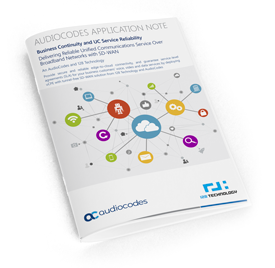Whenever I talk to enterprise IT leaders these days, the item at the top of the agenda is usually how to reconcile three independent and seemingly contradictory objectives, each of them representing a challenge in its own right.
These objectives are:
- To maintain business continuity (100% uptime) and the service level agreement (SLA) guarantees of their data, VoIP and media services while their workloads are partially or totally migrated to the cloud. This is especially true for quality-sensitive unified communications (UC) services, including cloud-based unified communications as a service (UCaaS) and hybrid on-premises UC/cloud-based UCaaS services, as part of an all-IP transition.
- To take advantage of the heterogeneous mix of broadband WAN links available at branch offices that can replace (or augment) more expensive private MPLS links, without having to increase the number of edge appliances to handle the required additional WAN transport options and optimization functions.
- To ensure secure and resilient “last mile” connectivity from branch office sites to the cloud (private data center cloud, or public/SaaS cloud).
This is a particularly challenging puzzle when a “telco edge” is required to provide VoIP session border controller (SBC) and media gateway functionality, integration with on-premise legacy PSTN equipment, and secure and highly interoperable connection to VoIP cloud services.
Fortunately, a new AudioCodes SD-WAN solution addresses all three challenges and only requires a single appliance. The solution comprises a “telco edge” SD-WAN uCPE appliance - based on the AudioCodes Mediant 800 MSBR platform - that combines our state-of-the-art SBC and media gateway capabilities with application-aware routing algorithms that select optimal WAN paths to deliver application data under stringent SLAs. A new application note focuses on these concerns and explains our solution in more detail.
SD-WAN technology abstracts the WAN into a secured overlay across multiple underlying data services (such as xDSL, cable and 4G) and/or private connections (such as MPLS circuits). End-to-end path performance across available underlying services is determined, and optimal paths are selected based on application constraints, business priority and other metrics. Multiple paths may be selected to deliver application data to satisfy strict SLAs. For example, email replication, file transfers and other bandwidth-intensive, latency-tolerant applications may be sent across internet paths, while VoIP sessions, which are sensitive to jitter, delay and packet loss, can be sent across MPLS (or alternate internet paths with low jitter and packet loss).
Many of the enterprise IT leaders that I’m in touch with are familiar with SD-WAN and are regularly approached by SD-WAN vendors. There are anywhere from 40 to 60 vendors out there who purportedly provide SD-WAN solutions, some appliance-based and some requiring a generic “white box”, limited to only four to six Ethernet ports. A major concern I hear is the proliferation of “box” solutions that do not adequately address the reality and complexity of VoIP deployments, which in most cases include a mix of legacy PSTN and PBX/IP-PBX in transition towards a reliable, all-IP voice infrastructure and in the process of migration to the cloud.
One of the major advantages of the AudioCodes SD-WAN uCPE solution is that it supports multiple WAN transport technologies (including fiber, broadband Ethernet, xDSL, T1 and 4G/LTE), all types of local PSTN interfaces (including FXS, BRI and PRI), and multiple LAN ports with optional power over Ethernet (PoE) that provide easy connectivity to PCs and IP phones. This versatile product allows for multiple customer configurations and eliminates the need to deploy multiple “telco edge” boxes at the enterprise branch offices.
The SD-WAN features run as software on an AudioCodes Open Solutions Network (OSN) x86 server within our uCPE. They provide transport-independent routing and the dynamic policy-based selection of optimal paths to carry traffic for each application out of the multiple physical WAN links (MPLS, Internet, 4G/LTE and 5G) that are available. The SD-WAN engine abstracts the physical WAN links and establishes a secure overlay (tunneling) on top of the physical infrastructure. The performance of each physical WAN link is constantly monitored. Individual traffic flows are forwarded between SD-WAN capable sites (edge-to-cloud, edge-to-edge, edge-to-data center) across the physical WAN link best able to handle that flow’s SLA requirements, as defined by the network operator. Latency-sensitive traffic like VoIP can be prioritized across its entire path.
The AudioCodes SD-WAN solution is fully compatible with Microsoft Teams, Office 365 Skype for Business Online and Skype for Business.
After I’ve explained how AudioCodes can help voice and network IT professionals achieve their goals of maintaining business continuity (including 100% uptime for UC), taking advantage of a heterogeneous mix of broadband WAN links, and ensuring secure and resilient connectivity from branch office sites to the cloud, it’s fair to say that I often hear a very audible sigh of relief!
To find out more, read our Business Continuity and UC Service Reliability - Delivering Reliable Unified Communications Service Over Broadband Networks application note.




